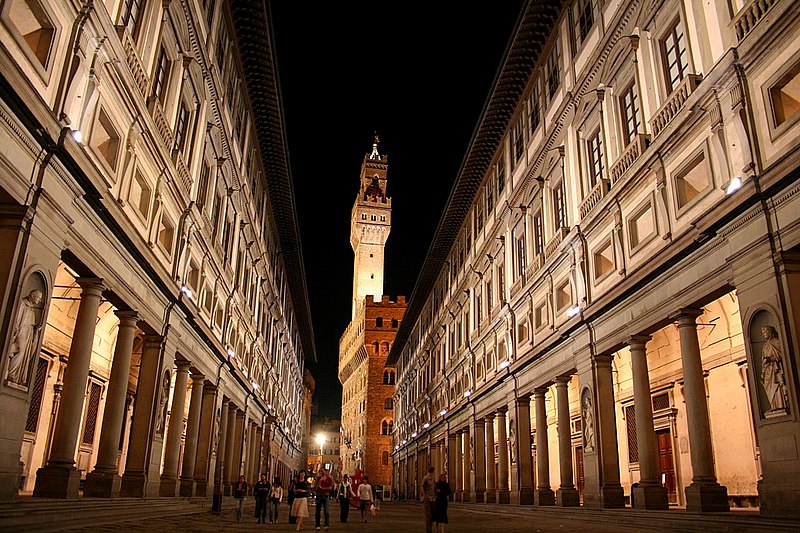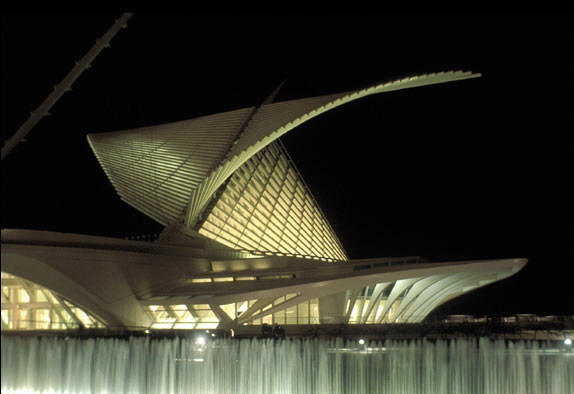
History
Construction of the palace was by Giorgio Vasari in 1560 for Cosimo I de 'Medici as the offices for the Florentine judge began - hence the name "Uffizi (" offices "). The construction was continued to Vasari's design by Alfonso Parigi and Bernardo Buontalenti and ended in 1581. The cortile (courtyard) is so long and narrow, and open to the Arno river in its rear end through a Doric screen that the space is articulated without blocking it, that architectural historians treat [2], when the first regularized streetscape of Europe . Vasari, a painter as well as architect, emphasized the perspective length by the matching facades' continuous roof cornices, and unbroken stand cornices between storeys and the three continuous steps on which the palace-fronts. The niches in the pillars, with columns deputy were filled with sculptures by famous artists of the 19th century.
The Palazzo degli Uffizi brought together under one roof the administrative offices, the tribunal and the state archive (Archivio di Stato). The project, by Cosimo I, Grand Duke of Tuscany was planned to arrange that prime works of art in the Medici collections on the first floor of Francis I of Tuscany, made from the famous Tribuna degli Uffizi Buontalenti in order that a United selection was made by the outstanding masterpieces of the collection in an ensemble, a star attraction was the Grand Tour.
collected over the years other parts of the palace in a display place for many of the paintings and sculptures of the Medici family developed or commissioned by them. According to Vasari, who not only the architect of the Uffizi, but also the author of the life of the artist, was published in 1550 and 1568, artists such as Leonardo da Vinci and Michelangelo gathered in the Uffizi "for beauty, for work and for the recreation. "[3]
After the house of Medici was extinguished, the art treasures of Florence was in reference to the famous Patto di famiglia by Anna Maria Luisa, negotiated the last Medici heiress, it was one of the first modern museums. The gallery was opened to visitors on request since the sixteenth century, and in 1765 it was officially opened to the public.
Owing to its huge collection, some of his works have transferred in the past to other museums in Florence - for example, some famous statues, the Bargello. A project is currently underway to expand the museum exhibition space of 2006 of around 6,000 meters ² (64,000 ft ²) to almost 13 000 m ² (139,000 km ²), so that public viewing of many artworks that are normally in storage were.
In 1993 a car bomb exploded in Via dei Georgofili and damaged parts of the palace, killing five people. The most serious damage was caused to the Niobe room, classical sculptures and neoclassical interior, restored, although its frescoes were damaged beyond repair. The identity of the bomber or bombers are unknown, although it almost certainly due to the Sicilian Mafia, which was engaged in a period of terrorism at that time.
Today, the Uffizi, one of the most popular tourist attractions of Florence. In high season (especially in July), waiting times can be up to five hours. Visitors who book a ticket in advance to wait a much shorter one.
In early August 2007 in Florence was caught with a big storm, and the gallery was partially flooded, with water leaking through the ceiling, and visitors were evacuated. It was a much larger flood in 1966, most of the art in Florence severely damaged, including the Uffizi Gallery.

No comments:
Post a Comment